
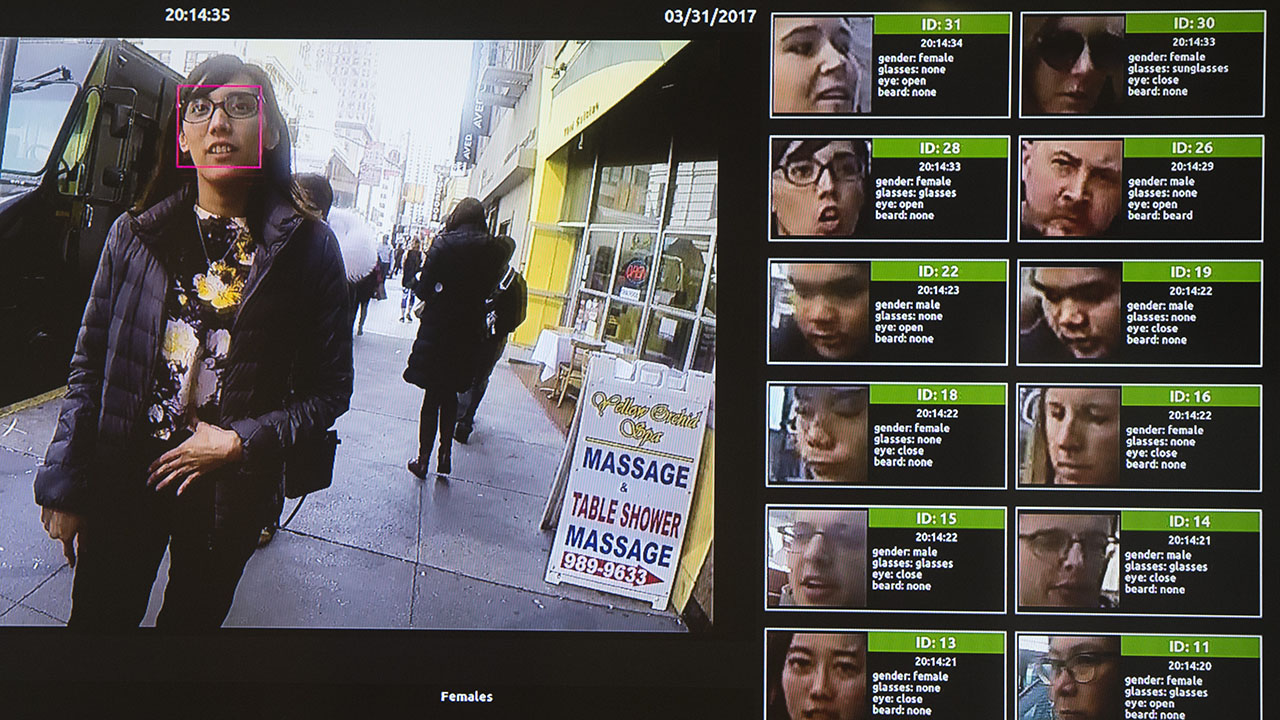
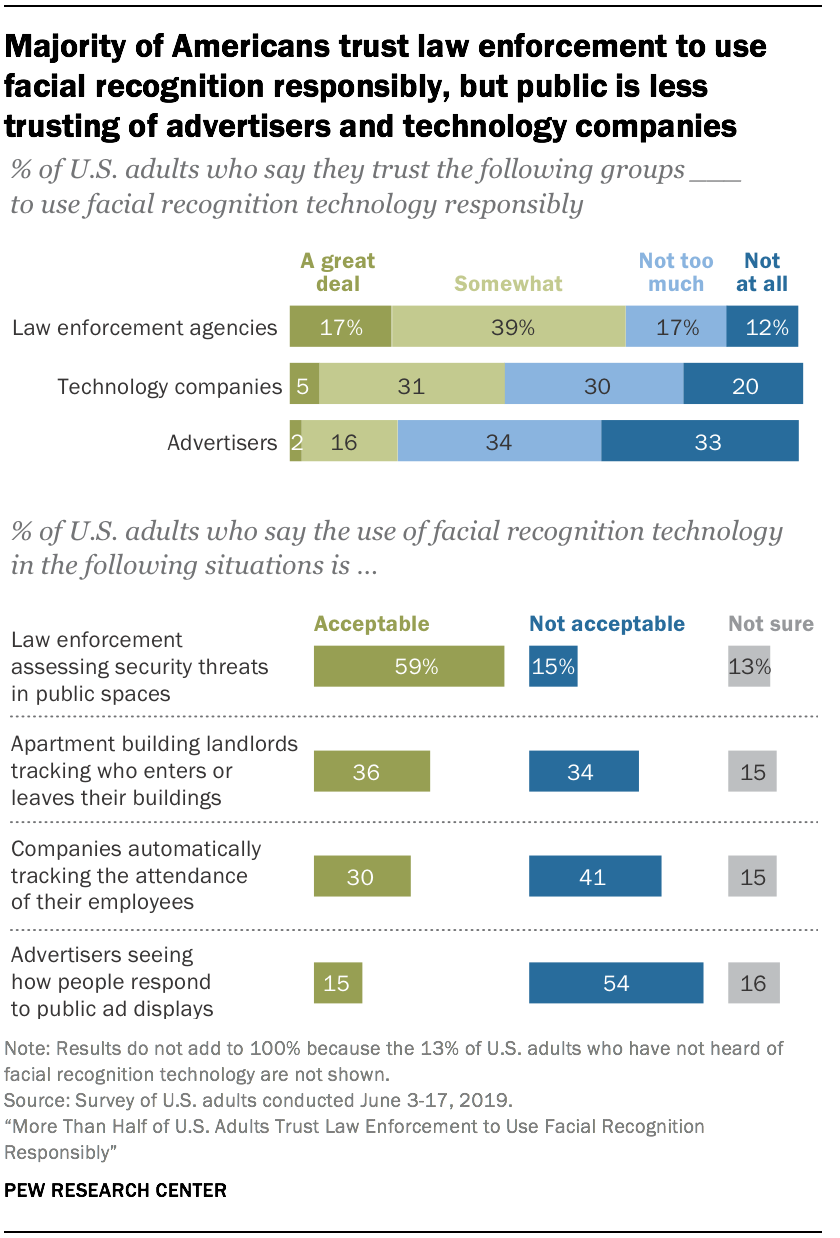
The ability of governments and law enforcement agencies to monitor the public using facial recognition was once the province of dystopian science fiction. But modern technology is increasingly bringing versions of these scenarios to life. A recent investigation found that U.S. law enforcement agencies are using state Department of Motor Vehicles records to identify individual Americans without their consent, including those with no criminal record. And countries such as China have made facial recognition technology a cornerstone of their strategies to police the behaviors and activities of their publics.
Despite these high-profile examples from fiction and reality, a new Pew Research Center survey finds that a majority of Americans (56%) trust law enforcement agencies to use these technologies responsibly. A similar share of the public (59%) says it is acceptable for law enforcement to use facial recognition tools to assess security threats in public spaces.
About our machine vision research
The Center has used a process similar to facial recognition known as machine vision to conduct research on gender representations in online search results and news stories on social media (our machine vision model could estimate whether an image showed a man or a woman, but was not able to identify individual people).
This report on facial recognition is part of a broader examination of social and technical issues relating to machine vision and facial recognition technologies. The other two products in this series are:
- A data essay describing how the Center built a machine vision algorithm to identify gender in images collected from the web. This essay highlights the importance of using diverse training data in building these types of algorithms and shows how these systems can fail in ways that are both unpredictable and hard to explain.
- An interactive feature that provides a deeper understanding of the way our machine vision system makes decisions about gender in images. Cover up portions of a face to see whether it causes our deep learning algorithm to change its guess about the gender of the person in the image.
At the same time, the survey finds that this relatively broad acceptance of facial recognition use by law enforcement does not necessarily apply to other entities that might use these technologies. Notably smaller shares of the public say they trust technology companies (36%) or advertisers (18%) to use facial recognition responsibly. And minorities of the public would find it acceptable for these tools to be used for purposes such as tracking who is entering or leaving apartment buildings (36%), monitoring the attendance of employees at a place of business (30%) or seeing how people respond to public advertising displays in real time (15%).
These attitudes also differ across demographic groups. For instance, a substantially smaller share of young adults think it is acceptable for law enforcement to use facial recognition to assess security threats in public spaces relative to older Americans. Similarly, smaller shares of black and Hispanic adults than whites think the use of facial recognition technology by law enforcement is acceptable, and the same is true of Democrats compared with Republicans.
These are among the main findings of a nationally representative survey of 4,272 U.S. adults conducted June 3-17, 2019.
Most Americans have heard about facial recognition technology, with one-quarter having heard a lot about it
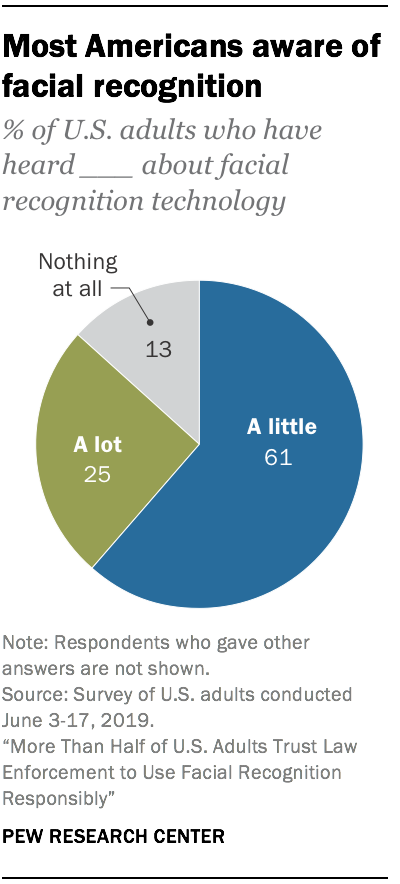
The American public has a broad awareness of automated facial recognition technologies that can identify someone based on a picture or video that includes their face. Most Americans – 86% in total – have heard at least something about facial recognition technology, with 25% saying they have heard a lot about these systems. Just 13% of the public has not heard anything about facial recognition.
Awareness of these systems is relatively widespread across a range of demographic groups, though there is modest variation in awareness based on factors such as educational attainment. Fully 95% of Americans with a college degree or higher have heard at least something about facial recognition technology, with 28% of college graduates saying they have heard a lot about it. But overall awareness falls to 79% (with 19% saying they have heard a lot) among those with a high school diploma or less. Awareness is also slightly higher among those with higher household incomes compared with those with lower incomes; among men relative to women; and among whites relative to blacks and Hispanics.
Notably, nearly identical shares of younger and older adults have heard of facial recognition technology – although younger adults are slightly more likely than older adults to indicate that they have heard a lot about it. (For details on awareness of facial recognition across demographic groups, see Appendix A.)
Majority of Americans trust law enforcement to use facial recognition responsibly; people are less trusting of advertisers, tech companies

When asked about their confidence that different entities will use facial recognition tools responsibly, the public expresses much greater trust in law enforcement agencies than in advertisers or technology companies. A 56% majority of U.S. adults trust law enforcement agencies at least somewhat to use facial recognition technologies responsibly, with 17% indicating that they trust these agencies a great deal to use facial recognition.
By contrast, around one-third of U.S. adults trust technology companies to use facial recognition technology responsibly, and just 18% trust advertisers with these technologies. Indeed, a mere 5% of Americans have a great deal of trust that technology companies will use facial recognition responsibly, and just 2% have high levels of trust in its use by advertisers.
Several groups express relatively low levels of trust in law enforcement agencies to use facial recognition responsibly – most notably black adults, younger people and those who identify as Democrats. Roughly six-in-ten whites trust law enforcement agencies to use facial recognition tools, but that share falls to 43% among blacks (an 18 percentage point difference). Comparable gaps in trust exist between 18- to 29-year-olds and those ages 65 and older, as well as between Democrats (including political independents who lean toward the Democratic Party) and Republicans and Republican leaners. Prior surveys by the Center of broader public attitudes toward law enforcement have found that roughly eight-in-ten Americans have confidence that police officers will act in the best interests of the public, and that warm views toward the police are especially prevalent among whites, older adults and Republicans.
Although white adults express higher levels of trust in the use of facial recognition by law enforcement relative to black adults, whites tend to express greater levels of distrust in other entities. Just 27% of whites say they do not trust law enforcement agencies to use facial recognition – but just over half (55%) of whites do not trust technology companies, and 73% feel this way about advertisers. A larger share of blacks (34%) than whites do not trust law enforcement to use these technologies responsibly. But notably smaller shares of blacks relative to whites express distrust in technology companies (34%) or advertisers (52%).
Americans more accepting of facial recognition use by law enforcement to assess public security threats than of use in other situations

When asked a separate set of questions about whether the use of facial recognition technology is acceptable under certain circumstances, the public again expresses more acceptance of these tools when used by law enforcement agencies than in other situations. A 59% majority of U.S. adults think it is acceptable for law enforcement agencies to use facial recognition technology to assess potential security threats in public spaces, while just 15% find this unacceptable. The rest are either unsure if this is acceptable or have not heard of facial recognition technology in the first place.
By comparison, larger shares of Americans find it unacceptable than find it acceptable for companies to use these technologies to automatically track the attendance of their employees (30% acceptable, 41% not acceptable), or for advertisers to use these tools to see how people respond to public advertising displays (15% acceptable, 54% unacceptable). The public is largely split on apartment building landlords using this technology to track who is entering or leaving their buildings: 36% think this is an acceptable use of facial recognition technology, but 34% think it is not.
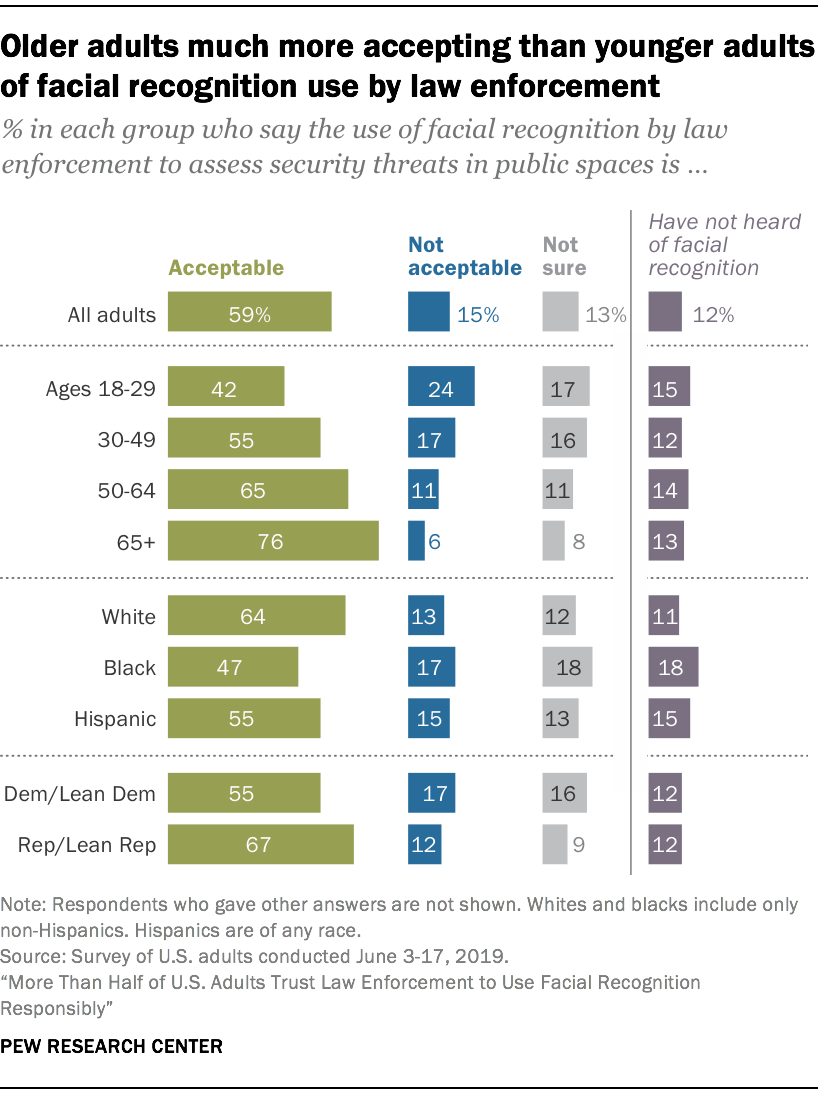
As was true of Americans’ trust in law enforcement to use facial recognition technology, views of how acceptable it is for law enforcement to use facial recognition in public spaces vary based on age, political affiliation and racial or ethnic background.
These differences are especially stark in the case of age. Fewer than half (42%) of 18- to-29-year-olds think it is acceptable for law enforcement agencies to use facial recognition to assess security threats in public spaces. But that share rises to 55% among those ages 30 to 49, to 65% among those ages 50 to 64, and to 76% among those 65 and older. Indeed, just 6% of older Americans think this is an unacceptable use of facial recognition technology.
Additionally, a larger share of whites (64%) finds the use of facial recognition in public spaces by law enforcement to be acceptable relative to the shares of blacks (47%) or Hispanics (55%) who say the same. And Republicans (including those who lean toward the Republican Party) are somewhat more accepting of facial recognition when used by law enforcement relative to Democrats and Democratic leaners – although a majority of each group finds this acceptable.
Majorities of Americans think facial recognition can effectively identify individual people, as well as classify them by gender and race
Despite some well-publicized examples in which facial recognition technologies have misidentified individual people or struggled to recognize certain types of faces, most Americans consider these tools to be relatively effective. Roughly three-quarters of U.S. adults (73%) think facial recognition technologies are at least somewhat effective at accurately identifying individual people. Smaller majorities think these tools are effective at accurately assessing someone’s gender (63%) or race (61%).
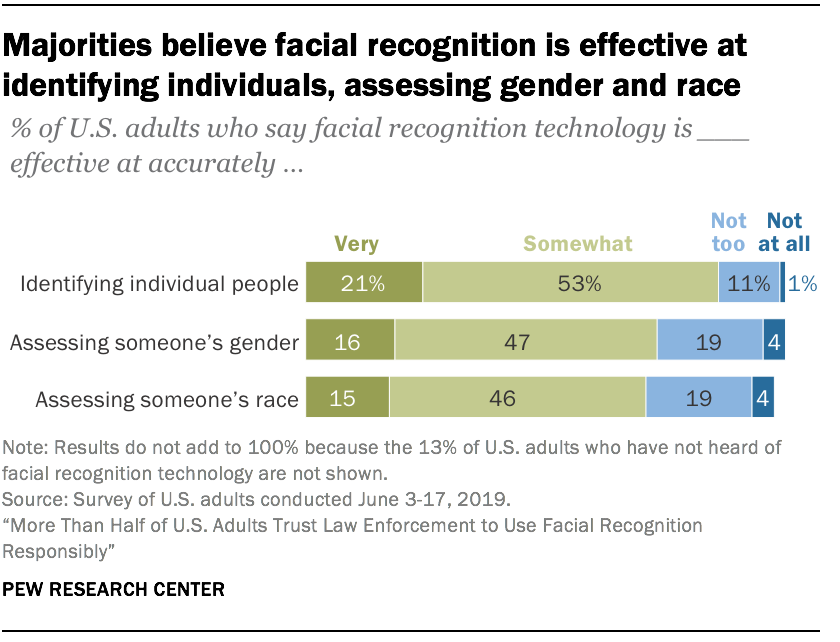
Larger shares of men than women think facial recognition tools are effective in each of these circumstances, and whites are consistently more likely to view them as effective than are blacks or Hispanics. Additionally, those who have heard more about facial recognition tend to have more positive opinions of its effectiveness in each of these areas. Relative to those who have heard only a little about this technology, Americans who have heard a great deal about facial recognition are roughly twice as likely to say these tools would be very effective at accurately identifying individual people (40% vs. 18% among those who have heard only a little), as well as accurately assessing someone’s race (28% vs. 13%) or gender (28% vs. 14%).




